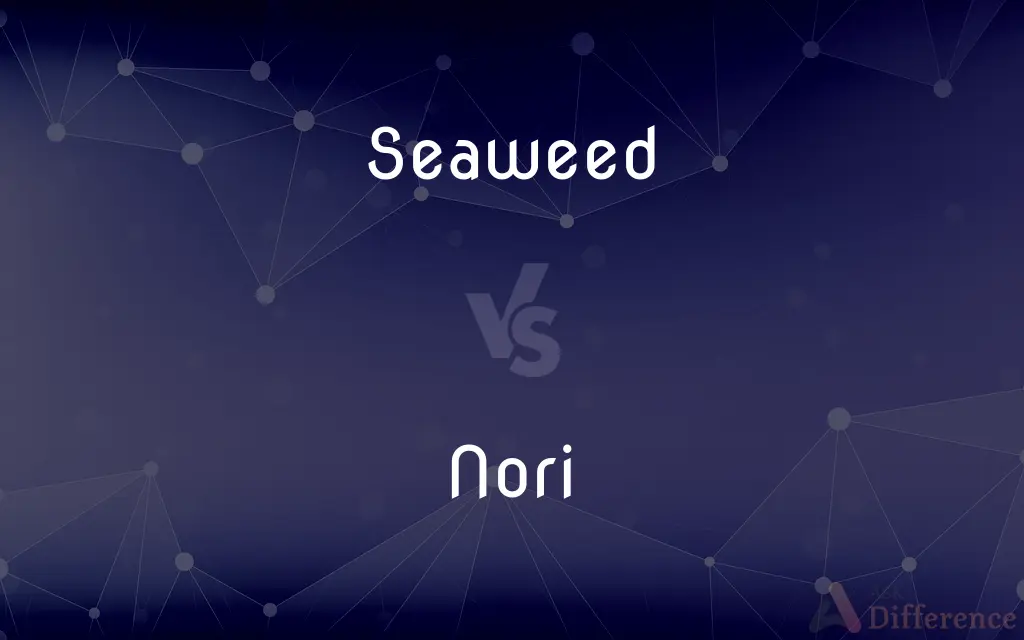Seaweed vs. Nori — What's the Difference?
Edited by Tayyaba Rehman — By Fiza Rafique — Updated on March 27, 2024
Seaweed refers to diverse marine algae, while Nori specifically denotes the dried sheets used in Japanese cuisine.

Difference Between Seaweed and Nori
Table of Contents
ADVERTISEMENT
Key Differences
Seaweed encompasses a wide range of marine algae, found in various parts of the world's oceans, providing essential habitats and food for marine life. Nori, on the other hand, is a specific type of seaweed that has been processed into thin, dried sheets, commonly used in Japanese cuisine, particularly for wrapping sushi.
There are several types of seaweed, including brown, green, and red varieties, each with unique characteristics and uses in cooking and industry. Nori is made primarily from red algae species in the genus Porphyra and is cultivated and processed through a specific method that results in its distinctive flavor and texture.
Seaweed is harvested for a variety of purposes, not just food, including as ingredients in cosmetics, fertilizers, and as a source of bioactive compounds for pharmaceuticals. Nori, whereas, is specifically cultivated for culinary use, prized for its umami flavor and nutritional benefits, including high protein content and vitamins.
The culinary applications of seaweed are diverse, ranging from salads and soups to being an integral part of dishes in various cultures. Nori is particularly associated with sushi and onigiri, playing a crucial role in the visual appeal and taste of these dishes.
Both seaweed and nori are valued for their health benefits, including being rich in vitamins, minerals, and dietary fiber. However, nori is often highlighted for its vitamin B12 content, making it a popular choice among vegetarians and vegans.
ADVERTISEMENT
Comparison Chart
Definition
A diverse group of marine algae.
A type of seaweed processed into dried sheets, used in Japanese cuisine.
Types
Includes brown, green, and red varieties.
Made from specific species of red algae (genus Porphyra).
Uses
Food, cosmetics, fertilizers, pharmaceuticals.
Primarily for culinary uses, especially sushi and onigiri.
Cultivation
Wild-harvested or cultivated in various marine environments.
Specifically cultivated and processed for consistent quality and flavor.
Nutritional Benefits
Rich in vitamins, minerals, and dietary fiber.
Notable for protein content and vitamins, including B12.
Compare with Definitions
Seaweed
Plays a crucial role in marine ecosystems as habitat and food for marine life.
Seaweed beds provide shelter and food for a diverse range of marine organisms.
Nori
A type of seaweed that is dried and pressed into thin sheets, widely used in Japanese cuisine.
Nori is essential for making sushi rolls, providing a distinctive taste and texture.
Seaweed
Used in food, cosmetics, and as biofertilizers.
Seaweed extracts are commonly found in skincare products for their hydrating properties.
Nori
High in protein, vitamins, especially B12, and minerals.
Nori is a valuable source of vitamin B12 for vegetarians and vegans.
Seaweed
Includes a wide variety of species across multiple families.
Kelp, a type of brown seaweed, is known for its rapid growth and extensive underwater forests.
Nori
An integral part of Japanese cuisine and culture.
Nori's popularity in Japan has led to its widespread use and appreciation globally.
Seaweed
A rich source of iodine, vitamins, and minerals.
Adding seaweed to your diet can help improve thyroid function, thanks to its high iodine content.
Nori
Primarily used for wrapping sushi and onigiri.
The crisp texture and umami flavor of nori make it ideal for sushi rolls.
Seaweed
Marine plants and algae that grow in the ocean, rivers, lakes, and other bodies of water.
Seaweed farms in coastal areas are a sustainable source of food and bioactive compounds.
Nori
Involves a complex cultivation and processing method.
Nori production is a precise art, requiring specific conditions for the algae to grow and be harvested.
Seaweed
Seaweed, or macroalgae, refers to thousands of species of macroscopic, multicellular, marine algae. The term includes some types of Rhodophyta (red), Phaeophyta (brown) and Chlorophyta (green) macroalgae.
Nori
Nori (海苔) is a dried edible seaweed used in Japanese cuisine, made from species of the red algae genus Pyropia including P. yezoensis and P. tenera. It has a strong and distinctive flavor, and is often used to wrap rolls of sushi or onigiri (rice balls).
Seaweed
Large algae growing in the sea or on rocks below the high-water mark
Seaweed glistened on the rocks
Seaweeds abound on most shores
Nori
An edible, dried preparation of red algae of the genus Porphyra.
Seaweed
Any of numerous marine algae, such as a kelp, rockweed, or gulfweed.
Nori
A type of seaweed, a red alga, laver (genus Pyropia, including species Pyropia yezoensis and Pyropia tenera).
Seaweed
A mass of such algae.
Nori
The seaweed, chopped and formed into sheets, used in the preparation of sushi.
Seaweed
Any of numerous marine plants and algae, such as a kelp.
Nori
A type of dried seaweed, pressed into sheets and used as a seasoning or as a wrapper for sushi.
Seaweed
(by extension) Any of various fresh water plants and algae.
Seaweed
Popularly, any plant or plants growing in the sea.
Seaweed
Any marine plant of the class Algæ, as kelp, dulse, Fucus, Ulva, etc.
Seaweed
Plant growing in the sea, especially marine algae
Common Curiosities
What is seaweed?
Seaweed refers to various marine plants and algae that grow in water bodies, used for different purposes.
What are the uses of seaweed?
Seaweed is used in foods, cosmetics, biofertilizers, and pharmaceuticals.
Is seaweed good for health?
Yes, seaweed is rich in nutrients like iodine, vitamins, and minerals.
What is nori?
Nori is a specific type of seaweed, processed into thin sheets, commonly used in Japanese cuisine.
Can all seaweed be used to make nori?
No, nori is specifically made from certain species of red algae.
How does seaweed support marine ecosystems?
Seaweed provides habitat and food for marine life, supporting biodiversity.
Can vegetarians eat nori?
Yes, nori is plant-based and offers a source of vitamin B12 for vegetarians.
How is nori made?
Nori is made by shredding red algae, pressing it into sheets, and drying it under the sun.
What nutritional benefits does nori offer?
Nori is high in protein, vitamins (including B12), and minerals.
What distinguishes nori from other types of seaweed?
Nori is specifically processed into sheets for culinary use, unlike other seaweeds used in various forms.
Why is nori important in Japanese cuisine?
Nori is crucial for dishes like sushi and onigiri, offering flavor, texture, and nutritional benefits.
Why is nori considered a superfood?
Due to its high content of essential nutrients, including protein and vitamins.
How is seaweed harvested?
Seaweed can be wild-harvested or cultivated in marine farms.
Are there environmental benefits to cultivating seaweed?
Yes, seaweed cultivation can improve water quality and sequester carbon.
What role does nori play in sushi making?
Nori wraps the sushi, adding flavor, texture, and nutritional value to the dish.
Share Your Discovery

Previous Comparison
Saver vs. Saber
Next Comparison
Celling vs. CeilingAuthor Spotlight
Written by
Fiza RafiqueFiza Rafique is a skilled content writer at AskDifference.com, where she meticulously refines and enhances written pieces. Drawing from her vast editorial expertise, Fiza ensures clarity, accuracy, and precision in every article. Passionate about language, she continually seeks to elevate the quality of content for readers worldwide.
Edited by
Tayyaba RehmanTayyaba Rehman is a distinguished writer, currently serving as a primary contributor to askdifference.com. As a researcher in semantics and etymology, Tayyaba's passion for the complexity of languages and their distinctions has found a perfect home on the platform. Tayyaba delves into the intricacies of language, distinguishing between commonly confused words and phrases, thereby providing clarity for readers worldwide.














































